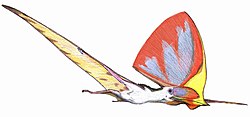Discovery and naming
The holotype specimen, FSAC-KK-10700, was discovered by local mine workers at Aferdou N'Chaft, a small mesa near the oasis village of Hassi el Begaa in the Errachidia Province in southeastern Morocco on the Algerian border, and consists only of the pterosaur's fragmented jaws. The specimen was purchased directly at the mine site by British palaeontologist David M. Martill in January 2017, and thus it was possible to confidently establish its precise locality and stratigraphic horizon. [1]
It is believed that Xericeps lived in the mid-Cretaceous period around the Albian–Cenomanian ages (93.9–113.0 Ma). [1]
The specific name, "curvirostris", comes from the Latin curvus, meaning "curved" and rostrum meaning snout, or muzzle, referencing the specimen's noticeably upward-curved beak. [1]
Description
Xericeps is a medium-sized edentulous (toothless) pterosaur. The term 'medium-sized', in the context of pterosaurs, is generally used to describe pterosaurs with a wingspan of 3–8 metres, and it is likely that Xericeps was nearer the lower end of this range. [1]
The holotype specimen is a partial anterior lower jaw, broken off anterior to where the mandibular rami diverged. The jaw is upturned, with the occluding surface curved in lateral view. On the dorsal surface of the mandibular symphysis are a pair of ridges, similar to those seen in Alanqa and Argentinadraco . [1]
This page is based on this
Wikipedia article Text is available under the
CC BY-SA 4.0 license; additional terms may apply.
Images, videos and audio are available under their respective licenses.













